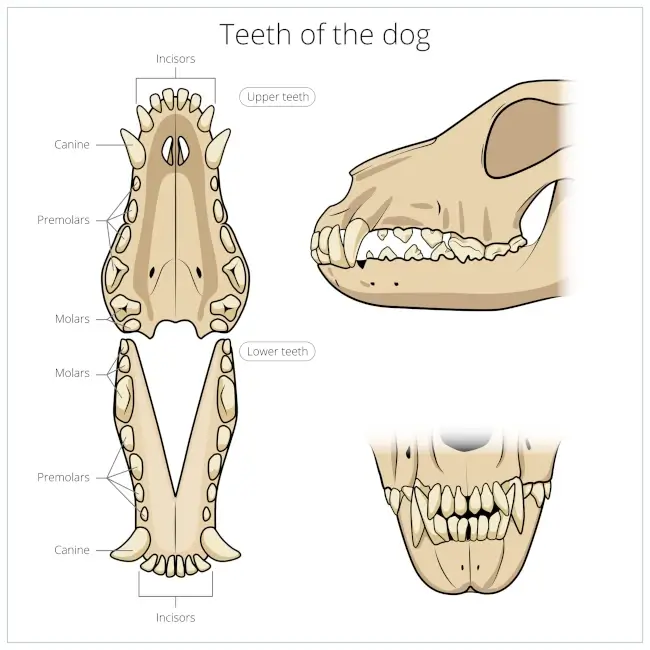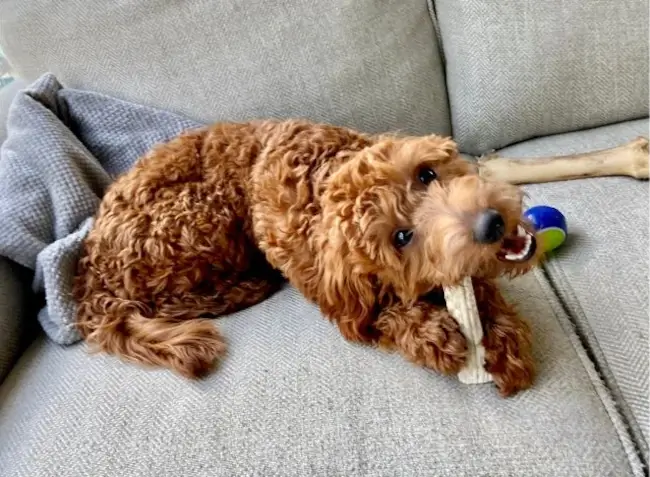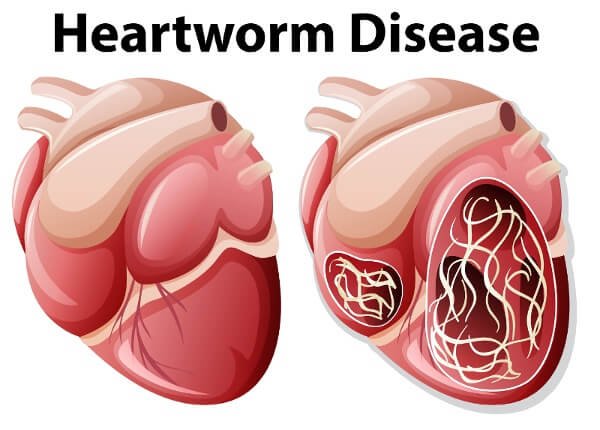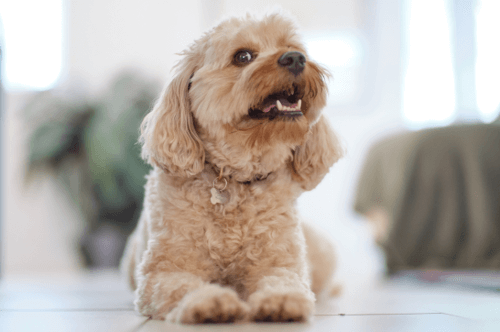When Do Cavapoos Stop Teething? Survive Your Puppy’s Chompers!

Are you the proud owner of a Cavapoo who just can’t resist chewing on everything in sight?
You’re not alone!
As cute as those little puppy teeth may be, they can cause quite a bit of trouble during the teething process.
In this article, we’ll delve into the world of Cavapoo teething and answer the burning question on every dog owner’s mind: when do Cavapoos stop teething?
Cavapoo baby teeth usually start falling out around 3 to 4 months of age, and the process continues until they are around 6 months old.
From tips on how to ease your pup’s discomfort to advice on how to help your puppy through this process, we’ve got you covered.
So let’s get to the bottom of this teething business once and for all.
How Many Teeth Do Dogs Have?
Dogs typically have 42 teeth, although this can vary slightly depending on the breed.
Adult dogs have 20 teeth in the upper jaw and 22 teeth in the lower jaw.
Puppies have fewer teeth, with 28 baby teeth that are eventually replaced by their adult teeth.

Cavapoo Teething Timeline
The order in which their baby teeth fall out and are replaced by adult teeth is generally as follows:
1. Incisors: The front teeth, both upper and lower, are the first to fall out, usually between 3 and 5 months of age.
2. Canines: The sharp, pointed teeth next to the incisors fall out next, usually between 4 and 6 months of age.
3. Premolars: The flat teeth behind the canines fall out next, usually between 4 and 6 months of age.
4. Molars: The large, back teeth are the last to fall out and are usually replaced by adult teeth between 5 and 7 months of age.
It’s important to note that the timing of tooth loss and adult tooth eruption can vary slightly from dog to dog, so it’s always a good idea to consult with a veterinarian to ensure that your puppy’s teeth are developing normally.
Symptoms of Teething in Cavapoos
Cavapoos are adorable and loving dogs that bring joy to any household.
However, as with all puppies, they go through the teething process, which can be a challenging time for both the dog and their owner.
Here are some common symptoms of teething in Cavapoos:
Chewing: Cavapoos love to chew, and during the teething process, they will chew on almost anything they can find.
Chewing helps to alleviate the pain and discomfort caused by the teething process.
Excessive drooling: As their teeth start to come in, Cavapoos may experience excessive drooling.
This is because the saliva glands are working overtime to help soothe their gums.
Loss of appetite: During the teething process, Cavapoos may experience a loss of appetite.
Their gums are sore, and it may be painful for them to eat.
Irritability: Teething can be a painful and uncomfortable process, which can make Cavapoos irritable and moody.
If you notice any of these symptoms in your Cavapoo, it’s important to provide them with the proper care and attention they need during this time.
This includes providing them with plenty of chew toys to help alleviate the pain and discomfort, as well as monitoring their diet to ensure they are getting the proper nutrients they need to stay healthy.
It’s also important to note that while teething is a normal part of a Cavapoo’s development, it can also be a sign of other health issues.
If you notice any unusual symptoms or behaviors in your dog, it’s always best to consult with your veterinarian to ensure they are getting the proper care they need.

Tips for Soothing a Teething Cavapoo
Teething can be a tough time for both puppies and their owners.
As a responsible pet parent, it’s important to help your Cavapoo through this phase as comfortably as possible.
There are ways to help soothe your teething pup.
Chew toys can help your Cavapoo satisfy their natural urge to chew and alleviate discomfort.
Choose toys that are safe and durable, and avoid anything that can be easily chewed apart and swallowed.
Cold temperatures can help numb your pup’s gums and relieve pain so try freezing a wet washcloth or offering frozen treats like carrots or berries.
You can also massage your Cavapoo’s gums with a clean finger or damp cloth to help alleviate discomfort and promote healthy teeth and gums.
If your Cavapoo is having trouble eating hard kibble, try switching to a softer food or soaking their kibble in water to make it easier to chew.
Another way is to keep your Cavapoo distracted with games and toys to help take their mind off of their teething discomfort.
Try playing fetch or engaging in other interactive playtime activities.
Remember, teething is a natural process that all puppies go through.
By providing your Cavapoo with the right tools and techniques, you can help make this phase as comfortable as possible and set them up for a lifetime of healthy teeth and gums.
Cavapoo Dental Issues
Like all dogs, Cavapoos are susceptible to dental issues that can affect their overall health and well-being.
Here are some of the dental issues commonly seen in Cavapoos:
- Periodontal disease: Periodontal disease is a common dental issue in dogs, including Cavapoos. It is caused by a buildup of plaque and tartar on the teeth, which can lead to inflammation and infection of the gums. If left untreated, periodontal disease can cause tooth loss and other serious health issues.
- Malocclusion: Malocclusion is a condition in which the teeth do not align properly, causing discomfort and pain. It can also lead to difficulty chewing and other dental issues.
- Tooth Decay: Tooth decay can occur when bacteria in the mouth break down food particles and produce acids that damage the teeth. Cavapoos can be prone to tooth decay due to their small size and the shape of their teeth.
- Retained Baby Teeth: Sometimes, a Cavapoo’s baby teeth may not fall out as their adult teeth come in, leading to retained baby teeth. This can cause overcrowding and misalignment of the adult teeth.
- Gum Disease: Gum disease is an inflammation of the gums that can be caused by a buildup of plaque and tartar. It can lead to bad breath, bleeding gums, and tooth loss if left untreated.
To prevent these dental issues, it’s important to establish a regular dental care routine for your Cavapoo.
This includes brushing their teeth regularly, providing appropriate chew toys, and scheduling regular dental check-ups with your veterinarian.
A healthy diet and proper nutrition can also promote good dental health in Cavapoos.

Puppy’s Teeth Not Falling Out?
If your puppy’s baby teeth are not falling out, it’s important to consult with a veterinarian as soon as possible.
Retained baby teeth can cause several problems, including overcrowding, misalignment, and dental disease.
This can lead to pain, difficulty eating, and other health issues.
In some cases, the retained baby teeth may need to be extracted by a veterinarian to allow the adult teeth to come in properly.
This is a relatively simple procedure that can be done under anesthesia and can sometimes be done at the same time as neutering.
Your veterinarian may also recommend dental cleanings or other treatments to ensure that your puppy’s teeth and gums stay healthy.
Regular dental check-ups are important for all dogs, but especially for puppies, as early intervention can help prevent more serious dental problems down the line.
How Do You Stop Your Puppy from Teething on You?
Puppies typically start teething around 3 to 4 months of age, and during this time, they may chew on anything they can get their teeth on, including you!
Make sure your puppy has plenty of appropriate chew toys to play with.
This can help redirect their chewing behavior away from you and onto the toys.
Provide a variety of textures and shapes, and consider toys that can be frozen or filled with treats to make them more appealing.
If your puppy starts to chew on you, redirect their attention to an appropriate chew toy.
You can do this by offering the toy and encouraging them to play with it.
Praise and reward them when they start chewing on the toy instead of you.
This will help reinforce the behavior and encourage them to continue chewing on the toy.
Rough play can encourage your puppy to chew on you, so it’s important to avoid roughhousing or playing in a way that encourages biting or nipping.
Teach your puppy bite inhibition by yelping or saying “ouch” in a high-pitched voice when they bite too hard.
This will help them learn to control the force of their bites and reduce the likelihood of accidental nipping or biting.
With patience and consistent training, you can help your puppy learn appropriate chewing behavior and reduce the likelihood of them teething on you.

When to Consult a Vet
While teething is a normal part of a Cavapoo’s development, there are times when you should consult a vet.
Here are some signs to look out for:
- Bleeding gums or mouth
- Excessive drooling or bad breath
- Lack of appetite or difficulty eating
- Unusual aggression or irritability
- Chewing on non-food items or furniture
If you notice any of these signs, it’s important to take your Cavapoo to the vet.
They can examine your dog’s mouth and determine if any underlying issues need to be addressed.
In some cases, a vet may recommend a special diet or dental treatment to help your dog through the teething process.
It’s also important to keep up with regular dental check-ups for your Cavapoo.
This can help catch any issues early on and prevent them from becoming more serious problems.
Final Thoughts On When Do Cavapoos Stop Teething?
Watching your furry friend grow and develop is an exciting journey, and the teething process is just a small part of it.
While it can be challenging at times, providing your Cavapoo with the care and attention they need during this time can make all the difference.
So if you’re currently dealing with a teething Cavapoo, don’t fret!
Keep in mind that this phase will pass, and soon enough, your pup will have a healthy and happy smile to show off.
And who knows, maybe one day you’ll look back on these teething struggles and laugh at the memories.






